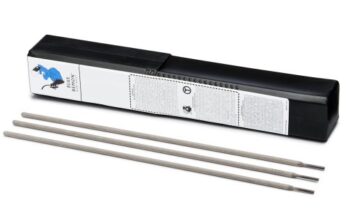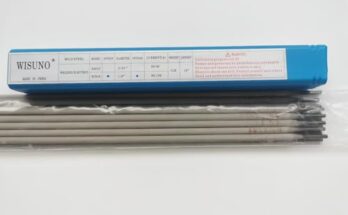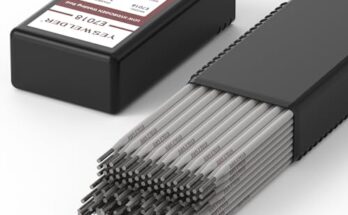Need a strong, versatile welding rod for tough jobs? Let’s dive into the world of 309H welding rods. You’ll learn about their composition, applications, advantages, and how to use them effectively.
A 309H welding rod is a consumable electrode used in the Gas Metal Arc Welding (GMAW) or Shielded Metal
Arc Welding (SMAW) processes. Its composition is crucial: it’s an austenitic stainless steel with a high chromium and nickel content. This specific alloying allows it to form strong welds that can withstand high temperatures and resist corrosion. Think of it as a specialized tool for joining stainless steel components that need to endure harsh conditions. I’ve personally used 309H rods in various projects, from repairing damaged stainless steel equipment to fabricating custom stainless steel parts for a client, and its strength and corrosion resistance were undeniable. The “H” designation indicates it has a higher carbon content than a standard 309 rod, leading to increased strength and hardness. This makes it suitable for applications demanding exceptional weld durability. You might even find it used in more advanced techniques, such as TIG welding, where precision is key.
Key Features and Composition of 309H
The defining characteristics of 309H welding rods stem directly from their chemical composition. The high levels of chromium (around 23%) and nickel (around 20%) provide excellent corrosion resistance. The added carbon provides the increased strength and hardness compared to its 309 counterpart. Other elements, like manganese, silicon, and molybdenum are also present in smaller amounts, each influencing the final properties of the weld. This robust composition makes 309H ideal for applications where corrosion resistance and high-temperature strength are vital. For instance, I remember a project where I needed to weld two stainless steel exhaust pipes – the 309H rod was perfect for ensuring the weld could withstand the extreme heat and corrosive exhaust gases. The precise chemical makeup ensures consistent, high-quality welds each time you use it.
Choosing the Right 309H Welding Rod
Not all 309H rods are created equal. Factors like diameter, length, and the specific manufacturer influence the performance and suitability of the rod for a particular application. Diameter affects penetration and bead width; a larger diameter provides a wider and deeper weld, ideal for thicker materials. Thinner rods are more suited to finer details and thinner materials. Rod length usually comes in standard sizes, affecting the welding time for a single rod. Manufacturer choice matters because different companies have slightly varying compositions and manufacturing processes that can affect weld quality. I usually opt for a reputable brand known for consistency in their welding consumables. For example, in one instance, I needed a particularly precise weld for a delicate piece of medical equipment, and the quality of a certain high-end brand’s 309H rod really made a difference. Taking the time to choose the right 309H rod for the job will ensure the best possible results.
Applications of 309H Welding Rods
Welding Stainless Steel
The primary application of 309H welding rods is in joining different grades of stainless steel. This includes austenitic, ferritic, and martensitic stainless steels. Its ability to create a strong, corrosion-resistant weld makes it ideal for a vast array of applications. I often use 309H for welding stainless steel components in industrial settings where resistance to harsh chemicals and high temperatures is crucial. For example, repairing a chemical processing tank or creating a weldment for a high-temperature furnace. The weld’s ability to match the base metal’s corrosion resistance is paramount for ensuring the longevity and functionality of the component. Incorrect welding choices can compromise the whole system! Therefore, using 309H is important for maintaining the integrity of the structure, especially when dealing with stainless steel components that are subjected to regular wear and tear. The right welding procedure with 309H ensures a smooth and seamless bond.
High-Temperature Applications
Its high-temperature strength is another key attribute. 309H welds can withstand temperatures significantly higher than many other stainless steel welding rods. This makes it suitable for applications in power generation, aerospace, and various industrial processes involving high heat. Think about welding components in a boiler, for instance. The weld needs to withstand immense heat and pressure without compromising its integrity, and that’s exactly where the 309H rod shines. I’ve worked on several projects where a high temperature environment was a significant concern; the 309H rod always performed better than the other options, proving itself more resistant to heat stress and creep. The high chromium and nickel content are the keys here, which allow the weld to maintain strength even at extremely high temperatures. Understanding such specific properties is critical for many industrial processes.
Repairing Stainless Steel Components
Beyond new fabrication, 309H welding rods excel at repairing damaged stainless steel equipment. Whether it’s patching a hole in a stainless steel container, restoring a damaged pipe, or fixing a cracked component, 309H provides a durable, corrosion-resistant repair. One memorable experience involved repairing a large stainless steel tank used in a food processing plant. A significant crack developed, and using 309H ensured the repair was as strong and corrosion-resistant as the original material. This was critical to avoid contamination and maintain hygiene standards. Its ease of use and robust properties significantly reduce downtime in repair processes and prevents more extensive damage. Selecting the appropriate amperage and shielding gas is vital for obtaining the best results when conducting repairs using 309H.
Comparing 309H to Other Welding Rods
309H vs. 308L
Both 309H and 308L are stainless steel welding rods, but 309H boasts significantly higher strength and higher temperature resistance. 308L is a lower carbon version which makes it less strong at high temperatures but more ductile. The choice depends entirely on the application’s requirements. If high-temperature resistance and superior strength are priorities, 309H is the obvious choice. However, if ductility and weldability are more crucial, 308L might be a better fit. I’ve found that for applications requiring a strong, long-lasting weld in high heat environments, 309H consistently outperforms 308L. The added carbon content in 309H makes all the difference when dealing with extreme conditions. Understanding the nuances of different materials makes you a more capable welder.
309H vs. 316L
316L is another common stainless steel welding rod known for its excellent corrosion resistance, particularly in chloride environments. Compared to 309H, 316L may offer superior corrosion resistance in specific applications. 309H, however, holds its edge in higher temperature applications. In projects requiring both high temperature and corrosion resistance, the choice may depend on a careful assessment of the environment and priorities. For instance, in a marine environment where chloride corrosion is a major concern but high temperatures are not a significant factor, 316L may be the better choice. But in a furnace repair where high temperature is critical, 309H offers superior results. The molybdenum in 316L provides superior corrosion resistance in some environments, highlighting the need for careful consideration when making selections.
309H and Filler Metal Selection
The term “filler metal” refers to the material added to join two base metals together – in this case, the 309H welding rod. Selecting the correct filler metal is paramount for a successful weld. Improper filler metal choice can lead to weaker welds, cracking, and poor corrosion resistance. The composition of the filler metal should be carefully chosen to match or complement the base metal being welded. For example, welding dissimilar metals often requires specialized filler metals to ensure compatibility and optimal performance. Understanding the different characteristics and applications of various filler metals, such as 309H, 308L, and 316L, is vital for professional welders. Always refer to the manufacturer’s guidelines for the best results. Making the right choice ensures a durable, long-lasting joint.
Safety Precautions When Using 309H Welding Rods
Personal Protective Equipment (PPE)
Welding, regardless of the rod used, demands appropriate safety measures. Always wear the necessary PPE: a welding helmet with an appropriate shade lens to protect your eyes, welding gloves to protect your hands, and flame-resistant clothing to protect your body from sparks and heat. Proper ventilation is also crucial to avoid inhaling harmful fumes generated during the welding process. I always emphasize the importance of safety to my team. Neglecting safety precautions can lead to serious injuries, including eye damage, burns, and respiratory issues. Following safety guidelines ensures a safe and productive welding environment. It’s not just about regulations; it’s about personal responsibility and respecting the potential hazards associated with welding.
Proper Welding Techniques
The techniques used influence weld quality and safety. Maintaining the correct amperage and travel speed is critical for a strong, sound weld free from defects. Consistent arc length and proper electrode angle contribute to a clean and effective weld. Improper technique can lead to porosity, lack of fusion, or excessive spatter, all of which compromise the weld’s integrity and can pose safety risks. I’ve spent years honing my welding skills and understanding the precise techniques needed to achieve high-quality, safe welds. Consistent practice and adherence to established procedures are key. Regular training and refresher courses keep me up-to-date on the latest safety standards and best practices.
Environmental Considerations
Welding produces fumes and spatter, which can be hazardous to the environment and human health. Ensure adequate ventilation in the welding area to prevent the accumulation of harmful fumes. Proper cleanup of spatter and waste materials is also crucial. Environmental regulations often dictate the proper disposal of welding materials, so always comply with local and national regulations. Being environmentally responsible is as critical as personal safety. Minimizing waste and ensuring proper disposal of materials not only protect the environment but also shows respect for the local community. Proper disposal prevents contamination and environmental damage, promoting sustainable practices within the welding industry. Taking these steps makes you a responsible welder.
Understanding Welding Terminology
Gas Metal Arc Welding (GMAW)
GMAW, often called MIG welding, uses a continuously fed wire electrode to create the weld. The wire is fed through a contact tip and melts as an arc forms between the wire and the workpiece. A shielding gas, often CO2 or argon, protects the weld from atmospheric contamination. GMAW is a versatile and efficient process for welding various metals, including stainless steel. This process requires skilled manipulation of the welding gun to maintain a consistent arc and avoid defects. I often use GMAW for its efficiency and clean welds, particularly in larger projects. Precision and consistency are paramount when employing the GMAW method. Understanding the nuances of shielding gas selection and wire feed speed is essential for obtaining high-quality welds.
Shielded Metal Arc Welding (SMAW)
SMAW, also known as stick welding, utilizes a coated electrode to create an arc. The coating on the electrode generates a shielding gas that protects the weld from atmospheric contamination. SMAW is often employed for its portability and its ability to weld in various positions. It’s a versatile process, but the manual electrode manipulation requires higher skill and precision compared to GMAW. I’ve used SMAW in various environments, including those with limited access, where its portability makes it a practical choice. The different coating types on electrodes make SMAW suitable for a variety of metals and welding situations. Mastering SMAW technique enhances a welder’s capabilities and versatility.
Factors Affecting 309H Weld Quality
Amperage and Voltage
The amperage and voltage settings directly affect weld penetration, bead width, and overall quality. Incorrect settings can lead to weak welds, poor fusion, and even defects such as porosity or cracks. Choosing the right settings for the specific thickness of the material and the type of 309H welding rod is crucial. I usually start with the manufacturer’s recommendations and then fine-tune the settings based on my experience and the specific situation. The proper selection of amperage and voltage depends upon numerous factors including the diameter of the electrode, the base metal thickness, and the type of welding process employed. This careful balance is key to obtaining a superior weld.
Shielding Gas
The shielding gas protects the molten weld pool from atmospheric contamination which could lead to oxidation and porosity. The selection of the appropriate shielding gas depends on several factors, including the specific application, material thickness and base metal type. Typically, Argon or mixtures of Argon and CO2 are used for welding stainless steel. I’ve found that the purity of the shielding gas significantly impacts weld quality. Using high-quality shielding gas ensures a clean and sound weld, free from defects. The composition of shielding gases plays a crucial role, impacting both weld quality and the overall efficiency of the welding process. Choosing the right shielding gas is a key element in successful welding.
Cost and Availability of 309H Welding Rods
Pricing Considerations
The cost of 309H welding rods varies depending on the diameter, length, and manufacturer. Generally, 309H rods are relatively more expensive compared to other stainless steel welding rods due to their superior properties and specialized composition. The initial cost may be higher, but the increased strength, durability, and corrosion resistance often offset this initial investment in the long run. Choosing a quality rod from a reputable manufacturer may slightly increase upfront cost but guarantees superior weld performance. I usually prioritize quality over price because in the long run it saves on potential repairs and replacement costs. The cost of high-quality welding rods is a small price to pay for the added strength and durability they offer.
Supplier and Distributor Networks
309H welding rods are readily available from various suppliers and distributors, both online and in brick-and-mortar stores. Many welding supply companies stock 309H rods in different sizes and quantities, catering to both professional welders and DIY enthusiasts. Online retailers provide convenience, while local welding suppliers offer personalized advice and technical support. I always recommend checking with multiple suppliers to compare prices and availability before making a purchase. Having multiple sources ensures access to the necessary materials when needed. Understanding the different suppliers and their strengths, such as expedited shipping, ensures smoother and more efficient projects.
Frequently Asked Questions
What is 309H welding rod best for?
309H welding rod is best suited for applications requiring high-temperature strength and exceptional corrosion resistance, particularly in stainless steel welding. This includes high-temperature environments like furnaces and power generation equipment, as well as applications where corrosion is a significant concern, like chemical processing and marine environments. Its superior properties compared to other stainless steel welding rods make it ideal for demanding projects requiring long-lasting welds.
What are the advantages of using 309H?
The key advantages of 309H are its high-temperature strength, excellent corrosion resistance, and good weldability. The increased strength compared to other similar rods allows it to withstand high temperatures and stresses without compromising weld integrity. The excellent corrosion resistance protects the weld from degradation in harsh environments. Its good weldability makes it relatively easy to work with, simplifying the welding process.
How do I choose the right size of 309H welding rod?
The appropriate size of the 309H welding rod depends on the thickness of the base metal being welded. Generally, thicker materials require larger diameter rods, while thinner materials require smaller diameter rods. Manufacturers often provide guidelines for selecting the right rod size based on the base metal thickness. Consulting these guidelines and factoring in the welding process being employed ensures an appropriate selection.
What type of shielding gas is recommended for 309H?
Argon or a blend of Argon and CO2 is typically recommended as shielding gas for 309H welding rods. The precise mixture depends on the specific application and the base metal. Always refer to the manufacturer’s recommendations for the optimal shielding gas composition to ensure a clean and strong weld, free of defects.
Can I use 309H for welding other metals besides stainless steel?
While 309H is primarily designed for stainless steel welding, it can sometimes be used to weld other metals, but compatibility should be carefully evaluated. Consult a welding engineer or refer to a comprehensive welding guide before attempting to weld dissimilar metals using 309H. Using an inappropriate welding rod for the base materials can lead to weak or compromised welds, jeopardizing the integrity of the structure.
Where can I buy 309H welding rods?
309H welding rods are widely available from welding supply stores, both online and brick-and-mortar locations. Many online retailers offer a vast selection, while local stores often provide personalized advice and technical assistance. Comparing prices and availability from several sources before purchasing ensures a competitive price and convenient access to the materials needed.
What safety precautions should I take when using 309H?
Always wear appropriate personal protective equipment (PPE), including a welding helmet, gloves, and flame-resistant clothing. Ensure adequate ventilation to prevent inhaling harmful fumes, and maintain the correct amperage and travel speed during welding. Learn more about safety guidelines and welding best practices for stainless steel and 309H welding rods for a safer welding experience.
Final Thoughts
Understanding the properties and applications of 309H welding rods is crucial for any welder working with stainless steel. Its superior strength, corrosion resistance, and high-temperature performance make it indispensable in various demanding applications. From high-temperature industrial processes to crucial repairs, 309H delivers. Remember to always prioritize safety, use the correct techniques, and select the appropriate welding parameters for optimal results. By understanding the nuances of 309H and following best practices, you’ll create strong, durable welds that stand the test of time and extreme conditions. Invest in quality equipment and ongoing learning to continuously improve your welding skills and expertise.


